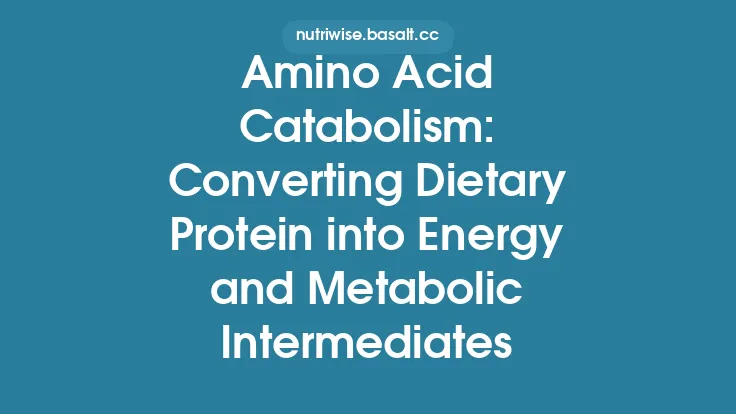Dietary fibers, long regarded primarily for their bulking and laxative properties, are now recognized as a dynamic source of metabolic substrates that shape human physiology far beyond the gastrointestinal tract. Unlike digestible carbohydrates, most fibers escape enzymatic hydrolysis in the small intestine and reach the colon largely intact, where they become the primary fuel for a dense and diverse community of anaerobic microbes. The microbial catabolism of these complex polysaccharides yields a suite of short‑chain fatty acids (SCFAs)—principally acetate, propionate, and butyrate—along with gases, phenolic compounds, and other metabolites. These SCFAs are absorbed by the colonic epithelium, enter the portal circulation, and are subsequently utilized by peripheral tissues as energy substrates, signaling molecules, and precursors for biosynthetic pathways. Understanding the metabolic fate of dietary fibers therefore requires an integrated view of (1) the physicochemical characteristics of fiber types, (2) the enzymatic repertoire of the gut microbiota, (3) the production and absorption of SCFAs, and (4) the downstream utilization of these metabolites in host energy homeostasis.
1. Classification of Dietary Fibers and Their Fermentability
| Fiber Type | Representative Sources | Solubility | Viscosity | Typical Fermentation Rate |
|---|---|---|---|---|
| Soluble, Viscous | Oats β‑glucan, psyllium, pectin | Soluble | High | Rapid (within 12–24 h) |
| Soluble, Non‑Viscous | Inulin, fructooligosaccharides (FOS), galactooligosaccharides (GOS) | Soluble | Low | Moderate (24–48 h) |
| Insoluble, Fermentable | Wheat bran, rye, some resistant starches | Insoluble | Low | Slow (48–72 h) |
| Insoluble, Non‑Fermentable | Cellulose, lignin | Insoluble | Low | Minimal (<10 % fermentation) |
The degree of polymerization, branching pattern, and presence of substituents (e.g., methyl‑esterified galacturonic acid in pectin) dictate how readily microbial glycoside hydrolases can access the glycosidic bonds. Soluble, low‑molecular‑weight fibers such as inulin are rapidly fermented, whereas highly crystalline cellulose resists enzymatic attack and contributes little to SCFA production.
2. Microbial Enzymology: From Polysaccharide to SCFA
The colonic microbiota harbors a vast repertoire of carbohydrate‑active enzymes (CAZymes) grouped into families such as glycoside hydrolases (GH), polysaccharide lyases (PL), and carbohydrate esterases (CE). Key steps include:
- Depolymerization – Extracellular GHs (e.g., GH5 cellulases, GH10 xylanases) cleave polymer chains into oligosaccharides.
- Transport – Specific phosphotransferase systems (PTS) or ATP‑binding cassette (ABC) transporters import oligosaccharides into bacterial cells.
- Intracellular Catabolism – Sequential glycolytic‑like pathways (e.g., the fructose‑6‑phosphate phosphoketolase pathway in Bifidobacteria) convert sugars to acetyl‑CoA and pyruvate.
- Fermentation to SCFAs – Acetyl‑CoA is channeled into distinct routes:
- Acetate via phosphotransacetylase (PTA) and acetate kinase (ACK).
- Propionate through the succinate, acrylate, or propanediol pathways, depending on the bacterial species.
- Butyrate via the acetyl‑CoA condensation pathway (butyryl‑CoA:acetate CoA‑transferase) or the butyrate kinase pathway.
The relative abundance of bacterial taxa (e.g., *Faecalibacterium prausnitzii for butyrate, Bacteroides* spp. for propionate) and the availability of specific substrates shape the SCFA profile emerging from a given fiber.
3. SCFA Production Kinetics and Quantitative Yields
In a typical adult consuming 25 g of fermentable fiber per day, total SCFA production ranges from 50 to 150 mmol · day⁻¹. Approximate molar ratios are:
- Acetate: 60 % (≈ 30–90 mmol · day⁻¹)
- Propionate: 20 % (≈ 10–30 mmol · day⁻¹)
- Butyrate: 20 % (≈ 10–30 mmol · day⁻¹)
These ratios are modifiable by diet (e.g., high‑inulin diets increase propionate) and by the host’s microbiome composition. The production rate follows a biphasic pattern: an early surge of acetate and propionate within the first 12 h, followed by a more sustained butyrate generation as slower‑fermenting fibers are metabolized.
4. Absorption Mechanisms Across the Colonic Epithelium
SCFAs cross the colonic epithelium via both passive diffusion (driven by the concentration gradient) and carrier‑mediated transport:
- Monocarboxylate Transporter 1 (MCT1, SLC16A1): High‑affinity transporter for all three SCFAs, expressed on the apical membrane of colonocytes.
- Sodium‑Coupled Monocarboxylate Transporter 1 (SMCT1, SLC5A8): Primarily transports butyrate and propionate, coupling uptake to Na⁺ influx.
- Diffusion of Undissociated Acid: At the colonic pH (≈ 6.5), a fraction of SCFAs remains protonated, facilitating passive diffusion.
Once inside colonocytes, butyrate is preferentially oxidized to CO₂, providing up to 70 % of the cell’s energy needs, whereas acetate and propionate are largely transported into the portal vein.
5. Hepatic Processing of Portal SCFAs
Upon reaching the liver, SCFAs follow distinct metabolic fates:
| SCFA | Primary Hepatic Pathway | Energy Yield (per mol) | Key Metabolic Contributions |
|---|---|---|---|
| Acetate | Conversion to acetyl‑CoA by acetyl‑CoA synthetase (ACS) | ~10 ATP (via TCA) | Substrate for cholesterol synthesis, fatty acid synthesis, and ketogenesis |
| Propionate | Gluconeogenic conversion to succinyl‑CoA via propionyl‑CoA carboxylase → methylmalonyl‑CoA mutase | ~4 ATP (net) | Significant contributor to hepatic gluconeogenesis, especially during fasting |
| Butyrate | Minor hepatic uptake (≈ 5 % of portal load) | ~10 ATP (if oxidized) | Mostly utilized peripherally; hepatic oxidation is limited |
The liver’s capacity to convert propionate into glucose is especially relevant for maintaining euglycemia during periods of low carbohydrate intake, whereas acetate serves as a versatile carbon donor for lipogenesis.
6. Peripheral Utilization of SCFAs
6.1 Skeletal Muscle and Heart
Acetate, after conversion to acetyl‑CoA, enters the tricarboxylic acid (TCA) cycle of peripheral tissues, contributing directly to oxidative phosphorylation. In muscle, acetate oxidation can account for up to 5 % of total ATP production during moderate exercise when dietary carbohydrate intake is high.
6.2 Adipose Tissue
Acetate is a preferred substrate for de novo lipogenesis in adipocytes. The enzyme ATP‑citrate lyase (ACL) utilizes cytosolic acetyl‑CoA derived from acetate to generate fatty acids, especially under insulin‑stimulated conditions. Propionate, however, is a poor lipogenic substrate and may even inhibit lipogenesis by activating AMP‑activated protein kinase (AMPK) through its conversion to succinyl‑CoA.
6.3 Brain
SCFAs cross the blood‑brain barrier via MCTs expressed on endothelial cells. While the brain’s reliance on glucose remains dominant, acetate can serve as an alternative fuel for astrocytes, supporting neurotransmitter synthesis (e.g., acetylcholine) and modulating neuroinflammation.
7. SCFAs as Signaling Molecules
Beyond their caloric contribution, SCFAs act as ligands for G‑protein‑coupled receptors (GPCRs) that orchestrate systemic metabolic responses:
- FFAR2 (GPR43): Activated by acetate and propionate; modulates insulin secretion, adipocyte lipolysis, and neutrophil chemotaxis.
- FFAR3 (GPR41): High affinity for propionate and butyrate; influences sympathetic nervous system activity and energy expenditure.
- HCAR2 (GPR109A): Specific for butyrate; promotes anti‑inflammatory pathways in colonic macrophages and dendritic cells.
Through these receptors, SCFAs influence appetite regulation (via peptide YY and GLP‑1 release), insulin sensitivity, and even circadian rhythm entrainment.
8. Energy Yield of Fiber Fermentation Compared with Classical Carbohydrates
The net caloric value of fermentable fiber is lower than that of digestible starch because part of the energy is lost as gases (CO₂, H₂, CH₄) and because the ATP yield per mole of SCFA is less than that of glucose oxidation. Approximate values:
- Digestible carbohydrate (glucose): ~4 kcal · g⁻¹
- Fermentable fiber (average SCFA profile): 1.5–2.5 kcal · g⁻¹
Thus, a diet high in fermentable fiber can modestly reduce total energy intake while still providing a meaningful contribution to the host’s energy pool.
9. Factors Modulating the Metabolic Fate of Dietary Fibers
- Microbiota Composition: Antibiotic exposure, probiotic supplementation, and long‑term dietary patterns reshape the CAZyme repertoire, altering SCFA ratios.
- Fiber Physical Form: Particle size, degree of processing, and matrix interactions affect accessibility to microbial enzymes.
- Transit Time: Faster colonic transit reduces fermentation time, lowering SCFA production; constipation can increase SCFA yield but may also promote putrefactive metabolism.
- Host Genetics: Polymorphisms in SCFA transporters (e.g., SLC16A1) and receptors (FFAR2/3) influence absorption efficiency and downstream signaling.
10. Clinical and Nutritional Implications
- Metabolic Health: Elevated colonic butyrate production is associated with improved insulin sensitivity and reduced visceral adiposity. Propionate supplementation has been shown to attenuate postprandial glucose excursions.
- Colonic Health: Butyrate serves as the primary energy source for colonocytes, maintaining tight‑junction integrity and exerting anti‑tumorigenic effects via histone deacetylase inhibition.
- Weight Management: High‑fermentable fiber diets increase satiety hormones (PYY, GLP‑1) and modestly raise resting energy expenditure through FFAR3‑mediated sympathetic activation.
- Renal and Cardiovascular Benefits: Acetate-derived cholesterol synthesis can be modulated by fiber type; soluble viscous fibers lower LDL‑cholesterol by binding bile acids, while SCFA signaling influences blood pressure regulation.
11. Future Directions in Research
- Precision Prebiotics: Tailoring fiber blends to individual microbiome signatures to maximize beneficial SCFA production.
- Metabolomics‑Driven Biomarkers: Using circulating SCFA profiles to monitor dietary compliance and predict metabolic outcomes.
- Engineered Microbial Consortia: Introducing defined bacterial strains with optimized CAZyme sets to enhance specific SCFA outputs (e.g., butyrate‑producing *Clostridium* spp. for ulcerative colitis management).
In sum, dietary fibers occupy a unique niche in human metabolism: they are not merely inert bulking agents but are actively transformed by the gut microbiota into short‑chain fatty acids that serve as energy substrates, signaling mediators, and precursors for biosynthetic pathways. The balance among acetate, propionate, and butyrate—shaped by fiber type, microbial ecology, and host physiology—determines the net energetic contribution of fiber and its broader systemic effects. Appreciating this intricate metabolic cascade enables nutrition scientists, clinicians, and food technologists to harness dietary fibers for optimized health outcomes and sustainable energy balance.





